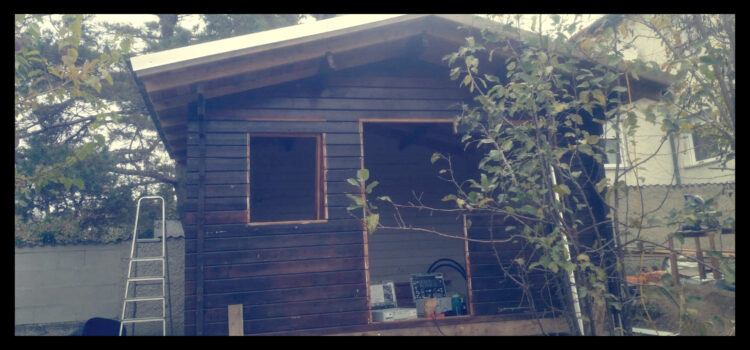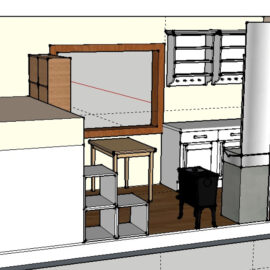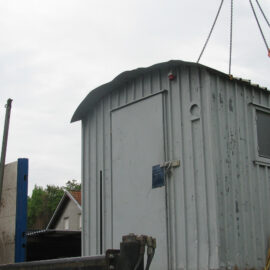
Almost two years ago I had the spontaneous, crazy impulse that I would like to put another Tiny House on my property, and I had to find it immediately, because after that one offer I found, there would probably never be another one like it on offer…
I had previously had my eye on another hut, but it was no longer available, so I went online to look for a second-hand hut. Basically, you can always find a wide variety of wooden huts either for free or cheaply for self-dismantling. But what these ads don’t tell you are the hidden costs involved.
The dismantling
If I remember correctly, I had 4-5 helpers spread over several days. But during the dismantling I quickly realized that it was quite a lot of work and that some of the materials were not so easy to dismantle, especially without breaking them. But here is my (more or less) complete list of what I learned during the dismantling:
- December is a bad time to tackle a project like this because no one has time to help (and it’s not particularly fun weather-wise either)
- nailed tongue and groove boards can basically be thrown away or burnt straight away, because no matter how careful you are, you can’t get them apart intact.
- everything always takes longer than planned (even if this is an exaggeration, I could recognize a clear tendency)
- if you dismantle a 3x4m hut, you also need a means of transportation where these lengths of wood can be transported
- Wooden huts are worse than Ikea when it comes to dismantling and reassembling
The construction
These wooden hut kits are quite nice, but they are like ready-made baking mixes. They still require various additional materials, as well as preparatory and finishing work, as in most cases they contain at most a very minimal floor or roof structure.

The foundation
In many stories, the foundation is often used as a metaphor for the fact that you need a good base because otherwise everything else will collapse. And in the case of large residential buildings, this is usually taken into account quite carefully. But with smaller huts, this point is often neglected. Before it was dismantled, my hut was only standing on 6 rocks and some 5-8 stacks, directly on the grass.
It was only during the planning with my construction specialist colleague that I became aware of many things that I would otherwise not have considered. Whether it’s the stability of the point foundations and the earth movements and frost problems, or the moisture that collects on the wood from the ground below and jeopardizes its longevity, if you do not spread fleece and gravel or something similar. But such wooden huts are rarely considered or built for durability.
The floor
An insulated floor is worth its weight in gold. Even in a small hut. At least if you want to use it for more than just storing equipment. And I definitely intend to do that.
Basically, I was already aware of the difference between insulation and mass during construction. Insulation prevents heat from escaping too quickly, while mass stores the respective temperature.
As I still had various building materials left over from the construction of my other (tiny) house and the dismantling of a roof structure, the plan was to insulate the floor using only existing (recycled) materials.

I still had a lot of cross-laminated timber board cut-outs and remnants that I had no use for, so my naive, simple mind thought that they would be best on the floor because they are heavy, and could then provide the mix of insulation and mass (wood is a special material because it is both insulation and mass – albeit not with the best values in each category).
However, my building colleague strongly advised me not to do this because it is not ideal for the floor to be cold and it will stay warmer with a pure insulating material. I’m yet to find out whether this is actually the case. But we did switch to the rock wool insulation that my father had rescued when he was dismantling a roof. So the floor is still made from recycled materials, but from materials other than the ones I intended to.
The walls
No matter how much you plan, everything is different on the building site.
Before dismantling, I was explicitly told that I should label all the parts of the house so that people would know how to put it back together afterwards. So I really went to a lot of trouble for this and labeled every single part. And the labeling had even survived the 2 years of storage quite well.
But things have to move quickly on the construction site. Especially in the steps where the building is not rainproof yet. And if the logs are not stored in the right order, there is no time to look up every piece as it was before. So you just start building and then hope that everything fits together in the end.
This strategy actually worked reasonably well (albeit with a few small mistakes), but it was pure horror for my inner control freak, who likes everything to be neat and perfect. But it was a good learning experience :-).
The roof
Roof constructions are also a science in themselves. You need roof battens and counter battens and rear ventilation and precise calculations for the angles of the roof shingles…
And if you’re like me and want to reuse material, you need a lot of hard-working helpers to remove hundreds of nails from the battens and boards before they can even be used.
I was also able to reuse the roof shingles from the other deconstructed roof, and that was even an advantage because they already had holes exactly where the nails were to be hammered in.

Recycling means a lot of extra effort
During the building process, I had a long discussion with my building colleague. He had a bad conscience about me having to pay more money because of the extra effort involved in preparing the materials (both for nailing and for cutting and finding the right pieces). In his opinion, it would have been a lot cheaper if I had bought the exactly matching wood.
And yes, he’s probably right about that. And especially if I hadn’t had helpers who helped me free of charge, it would have been a lot more expensive. This build has definitely shown me that it is at least very understandable why most people prefer to throw away building materials and buy new ones.
But it also shows me once again how completely distorted our market is. Because yes, it was a bit of extra work to remove those nails, but the effort of cutting down a tree, sawing it up, storing it and transporting it is supposed to be cheaper?
I simply could not reconcile it with my conscience and my values to ignore these hidden costs. But you definitely need a strong conviction if you want to go down this path.
The beauty of a recycled house
However, there are not only negative aspects to building with largely recycled materials. Especially when you know where they originally come from. Specifically, in the case of my little hut, I know that the wood for the floor comes from the same place as my other (tiny) house. This place – even if it no longer exists – carries a special energy with it, which is now part of the little house.

And the insulation and the roof come from my grandparents’ house. As a result, I will continue to have a connection to them for as long as this hut stands, and I can imagine that they are proud of what I have created.
The walls carry the memory of the dismantling of the hut. They remind me of the people who helped me with the dismantling and how grateful I felt that they took the time to help, even though the conditions were not ideal.
I have (not) built a hut
Even though the cabin is on my property and I helped build it, I can’t say that I built this cabin. Basically, my construction specialist colleague/friend planned and built the hut, and I and a few others helped – both directly with the construction and with the catering or preparation.
At the same time, however, it takes a lot of effort to organize such a construction and to make sure that everything really happens and runs as planned. So even if you help out as a builder but do less than others, it doesn’t mean that you haven’t contributed just as much to the construction.
Conclusion
I was close to despair several times during the build and swore I would never tackle a building project like this again. It’s all far too complex, time-consuming and stressful. At the same time, I also see a lot of truth in my colleague’s statement, who says that if we had to build a hut like this again, we would be much quicker because many of the issues that we had to laboriously work out the first around have already been clarified.
In general, however, I have to say that building projects, even if they are only “small” houses, should not be underestimated. Especially if you want the thing to stand for more than 1-2 years.



